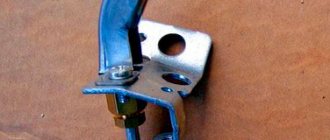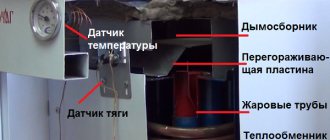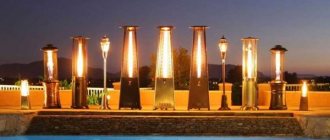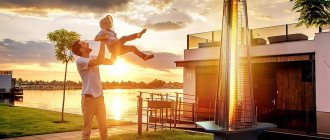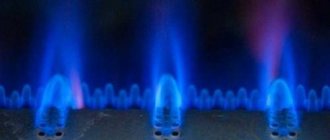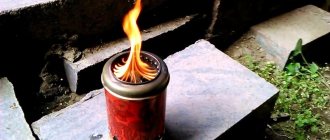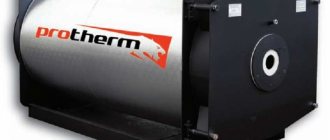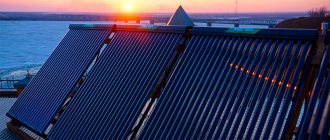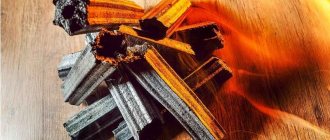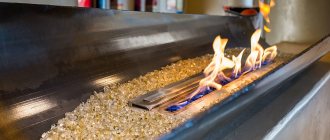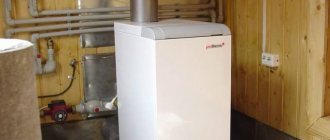Burner classification
Main functions of gas burners:
- supply of gas and air to the gas combustion front;
- mixture formation;
- stabilization of the ignition front;
- ensuring the required intensity of the gas combustion process.
Burners can be classified according to:
- gas combustion method,
- air supply method
- gas pressure,
- burner emissivity,
- the location of the burner in the combustion chamber.
According to the method of air supply, burners are divided into:
- to blowless ones, in which air enters the firebox due to rarefaction in it;
- injection, into which air is sucked in using the energy of a gas stream;
- blowing, in which air is supplied to the burner or firebox using a fan.
Burners can operate at different gas pressures:
- low – up to 5000 Pa,
- average – from 5000 Pa to 0.3 MPa,
- high – more than 0.3 MPa.
The most common are burners operating at low and medium gas pressures.
An important characteristic of the burner is its thermal power, kJ/h:
QT= QHVh, (1)
where QH is the lower calorific value of gas, kJ/m3; Vh – hourly gas consumption by the burner, m3/h.
There are maximum, minimum and nominal thermal powers of gas burners.
Maximum thermal power is achieved by long-term operation of the burner with high gas flow and without flame separation.
The minimum thermal power occurs when the burner operates steadily at the lowest gas flow rates without flame slip.
The rated thermal power of the burner corresponds to the operating mode with the rated gas flow rate, that is, the flow rate that provides the highest efficiency with the greatest completeness of gas combustion. The burner data sheets indicate the rated thermal power. The maximum thermal output of the burner should exceed the rated output by no more than 20%. If the rated thermal power of the burner according to the passport is 10,000 kJ/h, then the maximum should be 12,000 kJ/h.
An important characteristic of the burner is the thermal power control limit n = 2–5:
n = Qrmin/Qrmax (2)
where Qrmin is the minimum thermal power of the burner; Qrmax – maximum thermal power of the burner.
General requirements for all burners: ensuring complete gas combustion, stability with changes in thermal power, reliability in operation, compactness, ease of maintenance.
Diffusion burners
In such burners, the air required for gas combustion comes from the surrounding space to the front of the torch due to diffusion. Gas is supplied to the burner without admixture of primary air and mixed with it outside the burner. Therefore these burners are called external mix .
The simplest diffusion burners in design are a pipe with drilled holes. The distance between the holes is chosen taking into account the speed of flame propagation from one hole to another.
Industrial burners of the diffusion type include hearth slot burners (Fig. 1). They are a pipe with a diameter of up to 50 mm, in which holes with a diameter of up to 4 mm are drilled in two rows. The burner manifold is placed above the grate in a brick channel. The channel is a slot in the bottom of the boiler, hence the name of the burners - hearth slots.
Rice. 1. Hearth diffusion burner : 1– air regulator; 2 – burner; 3 – viewing window; 4 – centering glass; 5 – horizontal tunnel; 6 – brick lining; 7 – grate
From burner 2, gas exits into the furnace, where air enters from under the grate 7. Gas streams are directed at an angle to the air flow and are evenly distributed over its cross section. The process of mixing gas with air is carried out in a special slot made of refractory brick. Thanks to this device, the process of mixing gas with air is enhanced and stable ignition of the gas-air mixture is ensured.
Models with piezo ignition
The operation of this device is as simple as possible. The design does not become clogged, does not require additional heating, and eliminates the appearance of unpleasant odors. A gas burner with piezo ignition has a wide range of functionality; this type of modification is especially popular among tourists, hunters, and fishermen. In addition, the device is used for soldering certain materials.
Varieties:
- Portable models. They are a structure consisting of a cylinder with a fuel mixture and a special nozzle attached to a gas tank or through an adapter in the form of a hose. Features of this type include the ability to install cookware of a suitable diameter on the upper part of the body.
- Tabletop versions are horizontal devices with a large cooking surface. The gas cylinder is placed in the body part and fixed using a collet. Such modifications can be connected via a special adapter.
- Combination burners. The device is made in the form of nozzles, which are equipped with a small gas reservoir.
Injection burners
The main element of an injection burner is the injector, which sucks air from the surrounding space into the burners. Depending on the amount of air, burners can be equipped with incomplete air injection or with complete pre-mixing of gas and air.
Burners with incomplete air injection . In such burners, only part of the air necessary for combustion enters the combustion front; the rest of the air comes from the surrounding space. Such burners operate at low gas pressure and are called low pressure injection burners .
The main parts of injection burners are the primary air regulator, nozzle, mixer and manifold.
Low-pressure injection burners have a number of positive qualities, thanks to which they are used in household gas appliances, as well as in gas appliances for catering establishments and other household gas consumers. Injection burners are also used in cast iron heating boilers.
An important characteristic of incomplete mixing injection burners is the injection ratio: the ratio of the volume of injected air to the volume of air required for complete combustion of the gas. So, if 10 m3 of air is needed for complete combustion of 1 m3 of gas, and the primary air is 4 m3, then the injection coefficient is 4: 10 = 0.4.
A characteristic of burners is also the injection ratio - the ratio of primary air to burner gas flow. In this case, when 4 m3 of air is injected per 1 m3 of burned gas, the injection ratio is 4.
The limits of stable operation of injection burners are limited by the possibilities of flame separation and breakthrough. This means that it is possible to increase or decrease the gas pressure in front of the burner only within certain limits.
The advantage of injection burners is their self-regulating property, that is, maintaining a constant proportion between
the amount of gas supplied to the burner and the amount of injected air at constant gas pressure.
Burners with complete pre-mixing of gas and air . The injection of air necessary for complete combustion of the gas is ensured by increased gas pressure. Full gas mixing burners operate in the pressure range from 5000 Pa to 0.5 MPa. They are called medium-pressure injection burners and are used mainly in heating boilers and for heating industrial furnaces. The thermal power of burners usually does not exceed 2 MW.
These burners produce a low-luminous torch, which reduces the amount of radiation heat transferred to heated surfaces. To increase the amount of radiation heat, it is effective to use solid bodies in the furnaces of boilers and furnaces, which perceive heat from combustion products and radiate it to heat-receiving surfaces. These bodies are called secondary emitters. Fireproof walls of tunnels, walls of furnaces, as well as special perforated partitions installed in the path of movement of combustion products are used as secondary emitters.
Burners with complete pre-mixing of gas and air are divided into two types: with metal stabilizers and with refractory nozzles.
The injection burner designed by Kazantsev consists of a primary air regulator, a nozzle, a confuser, a mixer, a nozzle and a plate stabilizer (Fig. 2).
Rice. 2. Kazantsev injection burner : 1 – stabilizer; 2 – nozzles; 3 – confuser; 4 – nozzle; 5 – primary air regulator
The primary air regulator 5 of the burner simultaneously functions as a noise muffler, which is created due to the increased speeds of the gas-air mixture. Plate stabilizer 1 ensures stable operation of the burner without flame separation or flashover in a wide range of loads. The stabilizer consists of steel plates 0.5 mm thick with a distance between them of 1.5 mm. The stabilizer plates are pulled together by steel rods, which create a zone of reverse flows of hot combustion products along the path of the gas-air mixture and continuously ignite the gas-air mixture. In burners with refractory nozzles, natural gas burns to form a low-luminous flame. In this regard, the transfer of heat by radiation from the burning gas torch is insufficient.
Modern gas burner designs have significantly improved gas efficiency. The low luminosity of the gas plume is compensated by the radiation of hot refractory materials when burning gas using the flameless combustion method.
The gas-air mixture in these burners is prepared with a slight excess of air and enters hot refractory channels, where it intensively heats up and burns. The flame does not come out of the channel, therefore this gas combustion process is called flameless. This name is conditional, since there is a flame in the channels. The gas-air mixture is heated from the hot walls of the channel. In places where channels expand and near poorly bluffed bodies, retention zones of hot combustion products are created. Such zones are stable sources of constant heating and ignition of the gas-air mixture.
In Fig. Figure 3 shows a flameless panel burner. The gas entering the nozzle 5 from the gas pipeline 7 injects the required amount of air, regulated by the primary air regulator 6. The resulting gas-air mixture through the injector 4 enters the distribution chamber 3, passes through the nipples 2 and enters the ceramic tunnels 1. In these tunnels, the gas-air mixture is burned. Distribution chamber 3 is thermally insulated from ceramic prisms 8 with a layer of diatomaceous earth, which reduces heat removal from the reaction zone.
Rice. 3. Flameless panel burner : 1 – tunnel; 2 – nipple; 3 – distribution chamber; 4 – injector; 5 – nozzle; 6 – air regulator; 7 – gas pipeline; 8 – ceramic prisms
Flameless combustion of gas has the following advantages: complete combustion of gas; possibility of gas combustion with small excess air; the ability to achieve high combustion temperatures; combustion of gas with high thermal stress of combustion volume; transfer of a significant amount of heat by infrared rays.
Based on the design of their fire part, existing designs of flameless burners with refractory nozzles are divided into:
- burners with nozzles having channels of irregular geometric shape;
- burners with nozzles having channels of regular geometric shape;
- burners in which the flame is stabilized on the fireproof surfaces of the firebox.
The most common are burners with nozzles of regular geometric shape. The refractory nozzles of such burners consist of ceramic tiles measuring 65x45x12 mm. Flameless burners are also called infrared burners .
All bodies are sources of thermal radiation arising due to the vibrational motion of atoms. Each temperature corresponds to a certain range of wavelengths emitted by the body. In this case, heat transfer by radiation occurs in the infrared region of the spectrum, and burners operating on this principle are called infrared burners (Fig. 4).
Rice. 4. Infrared radiation burners : a – burner diagram: 1 – reflector; 2 – ceramic tiles; 3 – mixer; 4 – nozzle; 5 – body; 6 – collection chamber; b, c and d – burners GII-1, GII-8 and GK-1-38, respectively
Through nozzle 4 (Fig. 4, a) the gas enters the burner and injects all the air necessary for complete combustion of the gas. From the burner, the gas-air mixture enters the collection chamber 6 and is then directed into the fire holes of the ceramic tile 2. To avoid flame breakthrough, the diameter of the fire holes must be less than a critical value and be 1.5 mm. The gas-air mixture leaving the fire chambers is ignited at a low speed of its exit in order to avoid flame separation.
In the future, the speed of exit of the gas-air mixture can be increased (open the tap completely), since the ceramic tiles heat up to 1000 ° C and give up some of the heat to the gas-air mixture, which leads to an increase in the speed of flame propagation and prevention of its separation.
Ceramic tiles have about 600 cylindrical fire channels, which makes up about 40% of the surface of the tiles.
The tiles are connected to each other with a special putty consisting of a mixture of fireclay powder and cement.
If infrared burners operate on medium pressure gas, then special plates made of heat-resistant porous materials are used. Instead of cylindrical channels, they have narrow curved channels that end in expanding combustion chambers.
When gas is burned in numerous channels of various nozzles, the outer surfaces of the channels are heated to a temperature of approximately 1000 °C. As a result, surfaces acquire an orange-red color and become sources of infrared rays, which are absorbed by various objects and cause them to heat up.
In Fig. 4, b – d show the most common types of infrared burners. GII-1 burners have 21 ceramic tiles, a reflector and a distribution box. Using GII burners you can heat rooms and various equipment. Burners are also used to heat open areas (sports grounds, cafes, summer premises, etc.).
The GK-1-38 burner is successfully used for heating walls and plaster under construction, and heating people working in winter conditions. The burner can operate on natural and liquefied gases.
Types of gas burners
At the moment there is a wide variety of gas burners. All of them may differ from each other depending on the device, area of use, flame location, and so on.
The devices have become widespread due to their cost-effectiveness and high efficiency. Gas burners for baths have long replaced solid fuel stoves, especially if all the necessary communications are available.
A large number of private houses are heated by gas boilers. They can also be used to provide hot water. The main element of the boiler can be considered the burner. All other details are built around it.
Many of its characteristics depend on the choice of this element for the boiler, the main one being efficiency.
In this regard, every owner of a heating system needs to have a good understanding of this issue, both when purchasing heating equipment in a store and when making a gas burner for a boiler with their own hands.
Gas burner operation diagram.
Before we begin to describe the burners used in various tasks, it is necessary to understand that they are not just a nozzle through which the flame is supplied.
To ensure high efficiency, as well as stability of operation, the design of this element provides for the injection of air into the gas mixture.
According to the method of air supply, there are the following types of gas burners for furnaces:
- atmospheric;
- injection;
- blowers.
In addition, they can be single-stage, two-stage and modulated. In the first case, the boiler operates at constant power, and maintaining the set temperature is achieved through timely switching on or off.
The two-stage system provides two operating modes: nominal and half. In this case, the burner can automatically switch to half mode in case of warming.
Finally, the modulating system allows the boiler to smoothly regulate power from zero to nominal, which ensures the least wear and tear.
Gas burner in the bathhouse
When choosing a stove for a bath or sauna, first of all, we start from the communications connected to the house. It makes no sense to install a gas or infrared stove if you have direct access to firewood.
Moreover, many will say that the aroma of burning wood cannot be replaced by anything. It’s hard to argue with this, but accessibility to gas will solve many problems.
Gas stoves have a number of advantages over their solid fuel counterparts. This makes them more common.
Among the main advantages of such furnaces are the following:
- have smaller dimensions;
- ease of installation;
- high efficiency.
All gas stoves are more compact, which is achieved due to the absence of an ash pan and a large firebox. As a result, it doesn't take up much space. At the same time, they are able to quickly warm up fairly large spaces in a short period of time.
Gas stove for a bath.
Another advantage of a gas burner for a sauna is its ease of use. In order to set the required temperature in the bath, it is enough to set the desired mode. As a result, you can enjoy bathing procedures without thinking about the need to add firewood.
In addition, gas heaters are able to provide a constant temperature, while solid fuel stoves cannot boast of such an advantage. Many people are attracted to gas stoves because of their ease of use. They leave no ash or unburnt coals behind, and do not require special care.
An ordinary gas stove for a bath or sauna is a housing with a built-in burner, to which a fuel source is connected. On top of the body there is a tray for stones.
Experts advise using round stones from the sea or river bottom. It is these cobblestones that are considered the best and hardest. They will have to withstand prolonged heating up to 200°C and periodic watering to produce steam.
Gas furnaces also have a thermostat to control the temperature and a fuse that shuts off the gas supply if the fire goes out.
There are various options for sauna stoves. For example, you can purchase a model that includes a water tank. As a result, such a stove will perform two functions at once: heat the bathhouse and provide hot water.
Some models are sold without a tank, but it is possible to purchase one if necessary.
Currently, there is a huge selection of ready-made models of stoves for baths or saunas. All comply with all safety requirements and can be installed on your own without much difficulty. The main thing is to coordinate the installation project with the city fire and gas service.
In addition, this element can be made with your own hands. However, without experience working with such devices it will be difficult to do this, so it is better to pay attention to store-bought options.
Gas burners for boilers
Boilers are the central element of the heating system of a private home. Nowadays, gas boilers are most often installed because they are highly efficient and this type of fuel is the cheapest.
Choosing a suitable boiler from the huge variety that modern stores offer is not so easy.
Nevertheless, the average consumer can independently figure out the various boiler options by reading the information on the Internet or consulting with the seller. The situation is different when it comes to gas burners for stoves.
Usually, when buying a boiler, it already comes with a gas burner. This option is the most optimal. It is installed at the factory in accordance with the design features of the device.
In this case, there is no doubt that it is calibrated and installed correctly. The boiler is ready for operation immediately after installation, and the consumer does not need to do any additional actions.
Combustion chamber in a gas boiler.
If there is a need to install this element yourself, then you may encounter some difficulties. Despite the wide selection of gas furnace models, all burners perform the function of mixing gas with air and then directing it into the appropriate holes.
Depending on the method of air supply, the firebox can be open or closed. In the first case, air is supplied directly from the room, and combustion products are removed through the chimney.
In the second option, air is supplied and gases are removed using tubes passing through through holes in the wall.
In open systems, an atmospheric burner is usually used. It is a set of tubes with outlets for burning gas. Its operating principle is the same as that of a conventional gas stove. Moreover, its shape is rectangular, which allows you to increase the heating area and productivity.
It is most often used in the AOGV gas boiler. Boilers using this type of heating element are characterized by high reliability, ease of use, noiselessness, and small dimensions.
At the same time, boilers are not without drawbacks, including low performance. Such heaters are effective in rooms with a small area of up to 100 sq.m.
The low level of efficiency is associated with the open boiler chamber. The same factor determines the low level of safety.
If you have a wood boiler and access to a gas system, then it makes sense to convert it to gas. This will open up new possibilities for automation and eliminate the challenges associated with fuel supply.
A gas burner for solid fuel boilers is usually of the atmospheric type. The choice is due to the simplicity of its design. There is nothing to break in it, which means it will ensure high reliability and durability. Do-it-yourself gas burners for heating boilers work on the same principle as in conventional boilers.
To carry out installation, you can use an ash pan, and automation for monitoring and adjustment can be connected externally. There are boiler models that are already equipped with a burner that ignites the fuel.
In any case, installing a heating element in a solid fuel boiler should not cause significant difficulties.
In closed systems, air access to the burner is limited. In such devices, air is pumped using a fan or turbine. Mixing occurs in a clearly defined proportion. Such burners are called ventilated or blown. Their device is more complex.
They are a special design in the form of a barrel with double walls. The burner is located in the center, and the coolant fills the space between the walls of the device. It also provides a large heating area. The air required for combustion is supplied by a fan or turbine.
Due to the insulation of the central heating element, such systems have a high level of safety and high efficiency. Among the disadvantages, it is worth highlighting the high noise level during operation of this type of boiler.
There are also diffusion-kinetic gas burners and combined versions. A feature of the operation of the first type of burners is the partial supply of air necessary for combustion of fuel.
Gas boiler installation.
They are very rarely found in domestic boilers. Most often used in industry. A subtype of this type of device is hearth burners.
Combined versions can use not only gas, but also wood, fuel oil or diesel fuel as fuel. One device provides all the necessary conditions for operating on the specified types of fuel. This advantage will suit consumers who do not have a gas supply.
The purchase of such a system is relevant considering its use in various conditions. In addition, such heating elements are fully automated. User participation in the process of their work is minimized.
Control of fire intensity, fuel combustion mode and other parameters are fully automated.
At the same time, they are not without shortcomings. Among them: a complex device, low efficiency, high cost. Depending on the model of the combi boiler, it may be difficult to reconfigure the operation when switching from one type of fuel to another.
Sometimes this process is so complicated that it cannot be done without the help of a specialist from the gas service.
Tourist gas burners
Among fans of spending their leisure time hiking, gas burners for tourism are becoming popular. Finding yourself in the lap of nature, the appetite comes very quickly and the need for cooking arises. Of course, you can collect firewood and make a fire for this purpose.
However, weather conditions are often not on the side of travelers, and it is not possible to find dry branches. This may be due to high humidity, rain, or the hike may take place in the winter season. In such cases, a portable tourist gas burner will be indispensable.
The stores offer a wide range of such devices. According to the manufacturers, they greatly facilitate the process of cooking while camping.
In order to confirm these statements, colorful descriptions and various figures are given that do not mean anything to the average user, and sometimes this data is simply taken out of thin air.
Let's look at what you need to pay attention to and which camping heaters will be practical and economical.
On short hikes with a small group of people, it is advisable to use dry fuel. This solid fuel boiler is ideal in terms of weight, especially if you use ethanol gel.
It is a mixture of ethyl alcohol with a thickener. Sold in jars weighing up to 200 g. It burns with a slightly bluish flame that does not go out even in strong winds.
When traveling in the warm season, the most convenient are portable gas burners with piezo ignition. When choosing them, special attention should be paid to the method of attaching the gas cylinder for the camping burner. There are two methods of fastening: with and without a hose.
Many people do not think about this issue when purchasing this device.
However, options that screw onto a cylinder have a number of disadvantages:
- Instability. A design with a pan, the diameter of which is larger than that of the cylinder, can tip over even from a slight wind.
- The position of the cylinder is fixed and cannot be changed, which becomes especially critical during cooking at temperatures less than 10 ° C. In such cases, the cylinder must be turned over or heated. Usually, for this purpose, it is placed on a pan, which cannot be done in devices without a hose.
- Great height. During strong winds, the heat supplied to the pan is greatly dissipated. To reduce heat dissipation, use a wind shield, the height of which depends on the height of the burner.
- The previous drawback implies the need to remove the windshield when adjusting the flame.
- When liquid boils in a pan, it begins to splash out, which makes it difficult to access the valve that shuts off the gas, since the boiling water burns your hands.
When choosing a burner, an important parameter is its power. It is worth noting that store websites often provide figures that do not correspond to reality. Even manufacturers themselves measure power in different ways.
The given data for the boiling time of 1 liter of water may differ from the actual values by more than two times. There is no point in paying attention to these numbers. More important is the number of flame holes and the design of the burner.
To cook food for a group of up to 4 people, a minimum power will be enough, but for the purpose of cooking in a pan with a capacity of 2 to 6 liters, it is better to choose a powerful burner with a large burner diameter.
The design of the burner is also important in the process of choosing a burner. Here it is important to decide on the tasks that it should solve.
For heating water, a burner with a small diameter of up to 3 cm and a vertical flame outlet is ideal. It will be less likely to be blown away by the wind, but wind protection will still be needed.
At the same time, cooking porridge will be problematic. It will burn, no matter how you stir it, due to a small heating zone in the form of a small spot in the middle of the pan.
When using a burner at a temperature below 5°C, it becomes necessary to heat the gas. If you are planning hikes in the cold season, then you should definitely choose a burner with gas heating.
Heating is implemented in the form of a copper tube bent into a loop. The gas in it passes over the flame and heats up. This is necessary to transfer gas from liquid to gaseous state. Focus is needed precisely in cold weather, when the air temperature is not enough for the gas to evaporate.
When hiking or climbing in large groups in high mountains or in areas where it is difficult to get gas cylinders, you should choose a gasoline or multi-fuel burner.
The cost of gasoline is several times less than gas, it is highly efficient, and with long-term autonomy on a hike, you do not carry empty gas cylinders with you.
The ideal solution for this burner is purified gasoline or “Coleman fuel”, or in common parlance “galosh”. It does not pollute the burner and leaves virtually no combustion waste.
The disadvantages of this type of burner include their greater weight and cost, the need to purchase additional containers for fuel, as well as the need to preheat the fuel before starting work and more careful maintenance.
Forced air burners
In these burners, the air required for gas combustion is supplied to the burner using a fan, the process of formation of the gas-air mixture begins in the burner itself and ends in the firebox, the gas burns with a short and non-luminous flame. Burners with forced air supply are often called two-wire and mixing, since they completely mix the gas-air mixture.
The most common designs of these burners operate at low gas and air pressure (Fig. 5). However, some designs can also be used at medium gas pressure.
Rice. 5. Burner with low pressure forced air supply : 1 – nozzle; 2 – body; 3 – front plate; 4 – ceramic tunnel
The burners are designed for installation in boiler furnaces and other units with a small firebox volume, as well as in heating and drying furnaces.
Gas with a pressure of up to 1200 Pa enters nozzle 1 and leaves it through eight holes with a diameter of 4.5 mm. The holes are located at an angle of 30° to the burner axis. The burner housing 2 contains special blades that impart a rotational movement to the air flow. Thus, gas in the form of small streams intersects in a swirling air flow and a well-mixed gas-air mixture is created. The burner ends in a ceramic tunnel 4, which has a pilot hole.
The main advantages of such burners: the ability to burn large amounts of gas; wide range of performance control; the ability to heat air and gas to temperatures above the ignition temperature.
